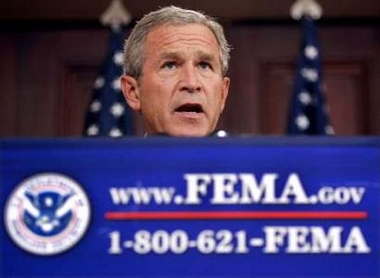Perception is not always reality
“Perception is reality” is the mantra of imagery advisors like Frank Luntz, and the bread and butter of political operatives like Karl Rove. They’ve prospered by their fidelity to this guiding principle.
It is in a sense a corollary of their major guiding principle which can be expressed as “Politics is real, governing is illusion.”
But Katrina has created realities that cannot be managed. This is one of its sobering lessons for us all.
The Bush political machine worked its electoral magic by stage managing events, creating photo op imagery, and “re-framing” issues through the skillful manipulation of media.
They formulate a single perspective in a few words, and make sure it is endlessly repeated by their officials and party minions, so that it inevitably gets on the air and in print, and their faithful followers take it up on talk radio and in their blogs. They also feed the media with the novelty it needs, like the “new faces” and sensational assertions in the “Swift Boat” ads.
But having attained their goal through these and other means---that is, they got elected and re-elected---they have attempted to govern guided by these principles, to further their political goals and reward their friends. They have been pretty successful at this. They weathered storm after storm that easily could have brought them down. Until Katrina.
Katrina was real, and its effects are real, and will continue to be very real for a very long time. The lack of adequate federal response is real, and had real effects. Right now they are attempting to spin their way out of their responsibility. But attempting to manage perception is also at least partly why they failed.
Consider some of what we know about FEMA and its response to Katrina, and to earlier storms. The first FEMA director under Bush was Joe M. Allbaugh, a former Bush campaign manager. Before he left, he hired Mike Brown as his deputy. Brown had been his college roommate, had run his unsuccessful electoral campaign, and had just left---or been forced out of—his position with the International Arabian Horse Association, where he apparently organized horse shows.
Brown’s Chief of Staff, Patrick Rhode, planned events for the Bush White House, and did advance work for the Bush campaign. His deputy was a media strategist for the campaign, and before that the marketing director for a software company.
None of them had emergency management experience.
Both of Brown’s key aides were essentially public relations specialists. Both of the directors had been political functionaries and Brown seems to have spent 11 years putting on shows with dumb animals, another qualification for political work.
Brown defended himself by pointing to other disasters he and his predecessor had successfully managed at FEMA. Yet their most conspicuous success seems to have been political.
An article in Perrspectives, which dubs FEMA the Federal Election Management Agency, reinterates the swift and massive response to four hurricanes in Florida just preceding the 2004 presidential election.
The article also cites hearings by the Senate Committee on Homeland Security and Government Affairs which revealed how generous Brown was with government relief funds, paying for home and car repairs in areas the hurricanes barely touched, and picking up the tab for over 300 funerals, more than twice the number of deaths attributed to the hurricanes.
In other words, some portion of $31 million in emergency relief payouts were political. They were up close and personal advertising, not with the goal of alleviating suffering but creating the perception that GW Bush was a good president, and Florida voters should show their gratitude at the polls.
Using relief fund for political purposes is hardly new, but add it to FEMA’s emphasis in Katrina, and managing perception appears to be not an adjunct but the major purpose of the Bush “relief efforts.”
Here are a few reported examples:
The Associated Press story quoting memos to the effect that Brown didn’t dispatch Homeland Security employees to the Katrina region until after the hurricane made landfall, and gave them two days to get there, had this final word: “Brown said that among duties of these employees was to "convey a positive image" about the government's response for victims.”
FEMA brought more than a thousand firefighters from around the country to Atlanta. They thought they were responding to the urgent plea of the Mayor of New Orleans for firefighters and search and rescue specialists. But they were instead kept there, and prepared to essentially be public relations representatives of FEMA. When 50 firefighters were finally dispatched to the Katrina zone, their mission was to stand around as
props for President Bush’s appearances.
On Wednesday, Sept. 7,
Reuters reports that FEMA is rejecting journalists’ requests to ride with rescue boats searching for storm victims, because it doesn’t want the media to photograph the dead.
None of this completely explains why FEMA was so late and so slow in its response, but it suggests that perception was an important consideration. This might help account for FEMA’s many documented refusals of help from Amtrak, the U.S. Navy, various corporations and individuals and so on, that would take them into the zone of destruction.
After all, it worked in Iraq. This administration has to some degree successfully managed perceptions of the Iraq war by limiting access to the war zone, forbidding the photographing of soldiers who died there, limiting access to prisoners at Guantanamo and fighting hard to prevent new photos and video from prisons in Iraq from becoming public.
But reporters were more easily able to get to the Katrina zone on their own, and some had family there. FEMA could not manage their perceptions, when they were staring at the reality.
Now America and the world have seen the stark reality of this disgraceful catastrophe. The spin is back in high gear, but the sobering reality continues to be seen and heard, and will be for some time to come.
This is a lesson for everyone who is engaged in politics, to understand that good governance is the goal, not political advantage. We must value a candidate’s qualifications and capabilities to govern as well as the candidate’s electability. That balance has eroded in recent years, but a catastrophe like Katrina may restore it in the minds of voters.
It is a lesson for those who habitually see reality chiefly through the lens of political perception, debating about message and re-framing and all the other tools of political perception management.
There is truly a sense in which perception creates reality, by being taken as an accurate reflection of reality. But we have also learned that managing perception does not always change reality. Sometimes reality has to be faced and dealt with, and managing the perception of it must be a secondary consideration, if it is considered at all.


